The elaborate appeal of Heath Robinson
- Published
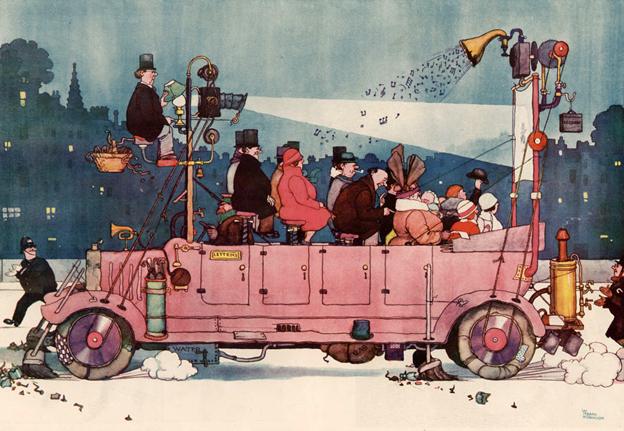
The building of a museum to house the work of William Heath Robinson will start this autumn. This great illustrator of absurd contraptions has bequeathed a curious legacy.
Heath Robinson is now part of the vernacular. The phrase transcends the man and has entered the English language. First seen in the dictionary in about 1912, Heath Robinson-ish/esque/like means an "absurdly ingenious and impracticable device".
The Wallace and Gromit film series is perhaps the greatest modern embodiment of the quality of Heath Robinson-ishness. When, in 1993's The Wrong Trousers, Wallace goes through a morning routine with an elevating bed sliding him through a hole and into a pair of trousers, it's familiar to Heath Robinson fans.
The 1934 Ideal Homes exhibition featured a 50ft by 30ft (15m x 9m) working model of Heath Robinson's perfect contraption-filled home. The figures inhabiting it were able to drop through the bedroom floor to the breakfast table, having been roused from their beds with a complicated set of pulleys.
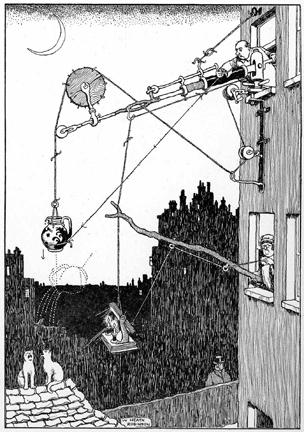
The "Multi-Movement Tabby Silencer" was "guaranteed to reach any part of the back yard"
In any field involving engineering, the term is bandied about regularly.
During the Falklands War, Royal Navy engineers dubbed their makeshift changes to the Sea Harrier aircraft the "Heath Robinson chaff modification".
And in World War Two the machine created by British code breakers at Bletchley Park, the predecessor to the world's first computer Colossus, was nicknamed Heath Robinson. It consisted of reels and spools, which had to be precisely aligned and timed in order for it to work.
"I believe they called the buggy in the moon landings the Heath Robinson contraption," says Mickie Robinson, the artist's daughter-in-law, who married his youngest son Tom. "Every time I hear someone use his name I do feel very pleased."
But while the term persists, memories of some of his work have faded a bit.
Heath Robinson's bizarre contraptions consisted of wheels, pulleys, counter-balanced ropes and weights - often powered by steam or musical instruments, or something else truly impractical. They were absurd - sometimes surreal.
His Multi-Movement Tabby Silencer - a device to spray water at noisy cats - comprised an extendable arm and a long stick, a wheel, numerous ropes (tied together in places), two candles, a mirror and a patterned china jug full of water. It took two people to operate, both hanging out of windows operating the machine with earnest intent and serious expressions.

Biography
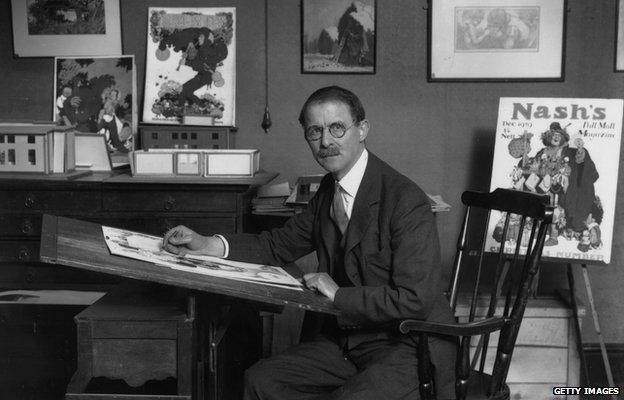
William Heath Robinson (1872-1944) English cartoonist and illustrator, was best-known for his drawings of complicated and outlandish inventions
Studied at Islington Art School and the Royal Academy
Wanted to be a landscape painter but began his career as a book illustrator
Famously drew cartoons of complicated contraptions which achieved simple results - satirising the self-importance of those caught up in the age of the machine
The term "Heath-Robinson contraption" came into official dictionary use in around 1912
Three sons fought in World War Two
Died after an exploratory operation in September 1944

The artist designed a fold-out garden, with a washing line suspended between two balloons, a baby's cot rocked by a foot pedal and a kennel for the dog - everything required by the new middle classes who had started living in flats and serviced apartments.
There was also a dinner table to help people "doing away with servants". It included a lever to tip the wine bottle, a Christmas pudding rising through the floor and what looks like an old-fashioned toilet cistern dropping clean plates for the diners to catch.
A number of contraptions were designed to help people take a photograph of themselves - the early selfie. One was powered by a well-aimed handgun, while another used a railway signal lever, a small air pump and some carefully knotted string.
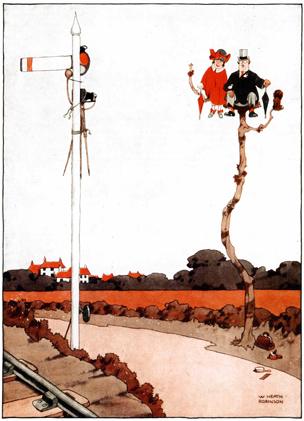
"Signal Invention - intelligent method of overcoming difficulties of taking one's own photograph"
His devices would never have worked.
"He was an artist - certainly in no sense was he an engineer, he couldn't really even drive a car," says Geoffrey Beare, author of numerous books on Heath Robinson.
"His work was really about the people using the machines, so it never dated."
The charm and quirkiness at the heart of Heath Robinson's work does feel very British, but there was a curious transatlantic symmetry with the American artist Rube Goldberg.
Where British people say Heath Robinsonish, Americans say Rube Goldbergian.
"Goldberg was a sewage engineer who drew cartoons," says Beare. "His devices would work, he understood engineering, but they were not beautifully drawn. Heath Robinson was an artist, his draughtsmanship was beautiful but the engineering was flawed."
Both captured the enduring playfulness of invention - a theme popular now with advertising executives and film-makers.
Honda's celebrated "cog" advert, external is very Heath Robinsonish. A small cog rolls into a larger one setting off a complicated chain reaction of car parts gently and precisely knocking into each other and wafting air to start the next motion. It has been watched almost 6m times on You Tube.
American toy company GoldieBlox received similar plaudits for their recent advert, external in which a selection of pink toys, feather boas, dolls and a skateboard are used to zip wire and roll around an entire house and garden - all to turn off the television.
Goldberg's contraptions have captivated people for decades
"There's a charm in looking at the machines and working out the clunky construction," says author Philip Pullman, a Heath Robinson devotee.
"We can't do that now - everything is hidden and digital. It's really a shame."
Heath Robinson's life included two world wars, the Victorian age of the machine and the rise of modernism - and all are reflected in his work.
Born in 1872, he grew up in artistic household in London. His father was an illustrator, as were his two older brothers Charles and Tom.
He trained at the Royal Academy and began his career painting landscapes and illustrating books, including Hans Christian Andersen's Fairy Tales and Shakespeare's A Midsummer Night's Dream.

Robinson had hoped to become a landscape painter
In the early 1900s Heath Robinson produced 250 illustrations - many of them macabre images of horned monsters with pointy tongues - for a two-volume Rabelais work. But the publishers soon ceased trading, and he was paid a fraction of what he was owed.
"It was perhaps due in part to the extravagance of his book," adds Beare. "He had a family and needed commissions so he started working for Tatler and The Sketch - upper class magazines."
"He worked from his studio at the bottom of the garden," adds Mickie Robinson. "It was a glorified shed really.
"He was prolific. He had to be to support his five children. He had to churn out all these illustrations for advertisements. Sometimes if he needed it, his brothers would have to come in and help, they were all very fine artists."
Robinson had a natural sense for the surreal, as his daughter-in-law recalls.
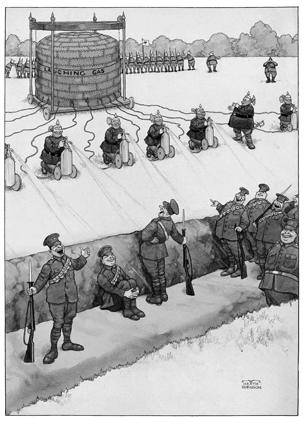
Germans "using siphons of laughing gas to overcome our troops before an attack"
"Tom had a school friend around for tea, his friend was slightly shy and nervous. Will came and sat down at the table wearing a lampshade on his head. The little boy had obviously been told by his parents to be terribly polite - well, he didn't know what to think of it. Will sat there with the shade on his head, without any expression at all. He had such a sense of fun."
Pullman adds: "He's funny, that was where his real genius was."
"It was his characters that were really amusing. It's their absurd solemnity - their pride at being very modern."
When World War One started, Heath Robinson was one of the first artists to belittle the Germans. He showed them using laughing gas to overcome British troops and parachuting in kettles of boiling water instead of firing bullets.
But WW2 saw three of his sons enlisted. Oliver, Quentin and Tom all served in the army, while his daughter Joan worked as a nurse. His other son Alan was a monk and thus did not fight.
Heath Robinson called it "the disastrous war", with an enemy too awful to mock.
"The Nazis were too terrible for such a gentle humorist," adds Beare.
He died in September 1944.
"He drew a picture once of an artist haunted by a strange little genius peering over his shoulder," says Mickie. "That was what he had - a little genius and a wonderful sense of whimsy."

The Heath Robinson Museum
Set up by the Heath Robinson Trust, the museum will be at West House community centre in Pinner, the north London suburb where Robinson lived
Awarded £1.13m from the Heritage Lottery in 2013
"We are looking to open in spring 2016 - but building work is due to start this autumn," says author Geoffrey Beare.
"We set up the Trust in 1992 and we've been looking for a home for his work ever since, so this is not before time."

Heath Robinson illustrations © The Estate of JC Robinson reprinted by permission of Pollinger Limited, external on behalf of The Estate of William Heath Robinson
Subscribe to the BBC News Magazine's email newsletter to get articles sent to your inbox.